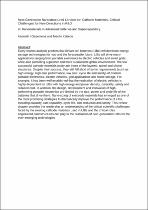 ResearchSpace
ResearchSpace
Next-generation nanostructured lithium-ion cathode materials: critical challenges for new directions in R&D
JavaScript is disabled for your browser. Some features of this site may not work without it.
- ResearchSpace
- →
- Research Publications/Outputs
- →
- Book Chapters
- →
- View Item
| dc.contributor.author |
Ozoemena, K

|
|
| dc.contributor.author |
Kebede, Mesfin A

|
|
| dc.date.accessioned | 2018-04-03T12:01:37Z | |
| dc.date.available | 2018-04-03T12:01:37Z | |
| dc.date.issued | 2016-07 | |
| dc.identifier.citation | Ozoemena, K and Kebede, M. 2016. Next-generation nanostructured lithium-ion cathode materials: critical challenges for new directions in R&D. In: Ozoemena K., Chen S. (eds) Nanomaterials in Advanced Batteries and Supercapacitors. | en_US |
| dc.identifier.isbn | 978-3-319-26080-8 | |
| dc.identifier.isbn | 978-3-319-26082-2 | |
| dc.identifier.issn | 1571-5744 | |
| dc.identifier.uri | http://link.springer.com/chapter/10.1007%2F978-3-319-26082-2_1 | |
| dc.identifier.uri | http://hdl.handle.net/10204/10160 | |
| dc.description | Copyright: 2016 Springer. Due to copyright restrictions, the attached PDF file only contains the abstract of the full text item. For access to the full text item, kindly consult the publisher's website. | en_US |
| dc.description.abstract | Every market analysis predicts that lithium-ion batteries (LIBs) will dominate energy storage technologies for now and the foreseeable future. LIBs will drive many applications ranging from portable electronics to electric vehicles and smart grids, while also permitting a greener and more sustainable global environment. The few successful cathode materials today are those of the layered, spinel and olivine structures. Despite their success, they still fall short of some requirements (such as high energy, high-rate performance, low cost, cycle life and safety) of modern portable electronics, electric vehicles, grid applications and home storage. For example, it has been well established that the realisation of electric vehicles is highly dependent on LIBs with high energy and power density, durability, safety and reduced cost. In addition, the design, development and innovation of high-performing portable electronics are limited by the size, power and cycle life of the batteries that drive them. Nano-sizing of electrode materials has emerged as one of the most promising strategies to dramatically improve the performance of LIBs, including capacity, rate capability, cycling life, cost reduction and safety. This review chapter provides the readership an understanding of the critical scientific challenges faced by the existing cathode materials used in LIBs and the critical roles engineered nanostructures can play in the realisation of next-generation LIBs for the ever-emerging technologies. | en_US |
| dc.language.iso | en | en_US |
| dc.publisher | Springer | en_US |
| dc.relation.ispartofseries | Worklist;17836 | |
| dc.subject | Lithium-ion batteries | en_US |
| dc.subject | LIBs | en_US |
| dc.subject | Energy storage technologies | en_US |
| dc.title | Next-generation nanostructured lithium-ion cathode materials: critical challenges for new directions in R&D | en_US |
| dc.type | Book Chapter | en_US |
| dc.identifier.apacitation | Ozoemena, K., & Kebede, M. A. (2016). Next-Generation nanostructured lithium-Ion cathode materials: Critical challenges for new directions in R&D., <i>Worklist;17836</i> Springer. http://hdl.handle.net/10204/10160 | en_ZA |
| dc.identifier.chicagocitation | Ozoemena, K, and Mesfin A Kebede. "Next-generation nanostructured lithium-ion cathode materials: critical challenges for new directions in R&D" In <i>WORKLIST;17836</i>, n.p.: Springer. 2016. http://hdl.handle.net/10204/10160. | en_ZA |
| dc.identifier.vancouvercitation | Ozoemena K, Kebede MA. Next-generation nanostructured lithium-ion cathode materials: critical challenges for new directions in R&D.. Worklist;17836. [place unknown]: Springer; 2016. [cited yyyy month dd]. http://hdl.handle.net/10204/10160. | en_ZA |
| dc.identifier.ris | TY - Book Chapter AU - Ozoemena, K AU - Kebede, Mesfin A AB - Every market analysis predicts that lithium-ion batteries (LIBs) will dominate energy storage technologies for now and the foreseeable future. LIBs will drive many applications ranging from portable electronics to electric vehicles and smart grids, while also permitting a greener and more sustainable global environment. The few successful cathode materials today are those of the layered, spinel and olivine structures. Despite their success, they still fall short of some requirements (such as high energy, high-rate performance, low cost, cycle life and safety) of modern portable electronics, electric vehicles, grid applications and home storage. For example, it has been well established that the realisation of electric vehicles is highly dependent on LIBs with high energy and power density, durability, safety and reduced cost. In addition, the design, development and innovation of high-performing portable electronics are limited by the size, power and cycle life of the batteries that drive them. Nano-sizing of electrode materials has emerged as one of the most promising strategies to dramatically improve the performance of LIBs, including capacity, rate capability, cycling life, cost reduction and safety. This review chapter provides the readership an understanding of the critical scientific challenges faced by the existing cathode materials used in LIBs and the critical roles engineered nanostructures can play in the realisation of next-generation LIBs for the ever-emerging technologies. DA - 2016-07 DB - ResearchSpace DP - CSIR KW - Lithium-ion batteries KW - LIBs KW - Energy storage technologies LK - https://researchspace.csir.co.za PY - 2016 SM - 978-3-319-26080-8 SM - 978-3-319-26082-2 SM - 1571-5744 T1 - Next-generation nanostructured lithium-ion cathode materials: critical challenges for new directions in R&D TI - Next-generation nanostructured lithium-ion cathode materials: critical challenges for new directions in R&D UR - http://hdl.handle.net/10204/10160 ER - | en_ZA |





